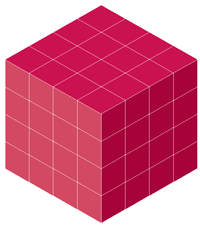Janifa’s Solution
I decided to follow the hints and think about a 2-Cube and a 3-Cube first. The 2-Cube was easy. Look at the picture. It has 8 small cubes, and all of them are painted on 3 sides. It doesn’t need any other cubes.
|
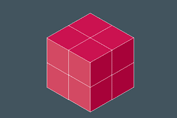 |
|
The 3-Cube was a little harder. Once I drew a 3-Cube, I could see that it had three layers of 9 cubes each, or 27 cubes total. Then I tried to figure out how many corners it had. Each corner is painted red on 3 sides, and I could see that there are 8 of them, just like the 2-Cube.
Then I put 2 dots on every cube I could see that had 2 sides painted red, and 1 dot on every cube that had just 1 side painted red.
|
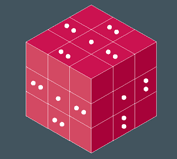
|
|
I could see a 1-dot cube in the middle of 3 visible sides, and I knew there were 3 sides I couldn’t see. So there must be 6 1-dot cubes, or 6 cubes painted on 1 side.
I could see that there were 4 2-dot cubes on the top of the 3-Cube. So there must be 4 more on the bottom. Then I went around the cubes on the middle layer. I could see 3 2-dot cubes, and I knew there was 1 more along the far edge that I couldn’t see. So there are 4 2-dot cubes in the middle layer. That makes 12 2-dot cubes altogether, or 12 painted on 2 sides.
So far I have
8 cubes painted on 3 sides
6 cubes painted on 1 side
12 cubes painted on 2 sides
|
|
That makes 26 cubes all together, so there must be 1 more cube in the middle that is all white.
I used the same reasoning and method for a 4-Cube. It has 4 layers of 16 cubes each, so it must have 4 x 16, or 64 cubes total. Just like before, I could see there are exactly 8 corners with 3 sides painted red. The number of corners doesn’t change. When I drew my 4-Cube, I put dots on the top side to see if I could figure everything out that way. I put 2 dots for cubes with 2 red sides and 1 dot for cubes with 1 red side.
|
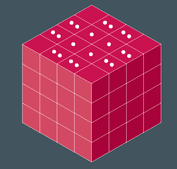
|
|
There are 4 1-dot cubes on the top side of the 4-Cube. Since there are 6 sides all together, there must be 6 x 4, or 24, cubes painted on 1 side.
There are 8 2-dot cubes on the top layer. There must be 8 more on the bottom layer. Then looked at the 2 middle layers. I decided to put dots on them to be sure.
|
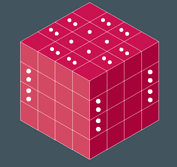
|
|
Now I could see 6 cubes with 2 dots, and I know there is one more on the hidden edge. So there are 8 2-dot cubes in the middle 2 layers. Adding in the 8 from the top and 8 from the bottom, there are 24 cubes painted red on two sides.
So far I have
8 cubes painted red on 3 sides
24 cubes painted red on 2 sides
24 cubes painted red on 1 side
That makes 56 cubes. So there must be 8 all-white cubes (a little 2-Cube) in the middle to make 64 cubes all together.
This is the answer to Problem 1.
For Problem 2, I put my data into a table. I used the patterns in the table and what I’ve already done to figure out the values for a 5-Cube and an N-Cube.
| Name of Cube |
Total Number of Cubes Needed |
|
| Number of Cubes Painted with: |
| 3 red sides |
2 red sides |
1 red side |
all white sides |
| 2-Cube |
8 |
8 |
0 |
0 |
0 |
| 3-Cube |
27 |
8 |
12 = (12 x 1) |
6 = (6 x 1) |
1 |
| 4-Cube |
64 |
8 |
24 = (12 x 2) |
24 = (6 x 2 x 2) |
8 |
| 5-Cube |
125 |
8 |
36 = (12 x 3) |
54 (6 x 3 x 3) |
27 |
| |
|
|
|
|
|
| N-Cube |
N x N x N |
8 |
12 x (N - 2) |
6 x (N - 2) x (N - 2) |
(N - 2) x (N - 2) x (N - 2) |
The last line is the answer to Problem 2.
Ming’s Solution
|
|
I used algebra to solve Problem 2 first. Then once I knew the formulas for an N-Cube, I just plugged in numbers for a 4-Cube to solve Problem 1.
I started by exploring the properties of a cube. I observed that every cube has 6 sides, 8 corners, and 12 edges. This allowed me to solve the problem using algebra.
|

|
|
First, to find the total number of small cubes needed for an N-Cube, I multiplied N by itself 3 times N x N x N, or N3.
Next I imagined what the corners would be painted. Each corner cube has to be painted red on three sides. Since there are 8 corners, every N-Cube has exactly 8 small cubes painted red on 3 sides.
|
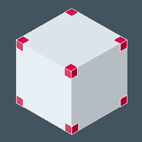
|
|
Next I sketched a cube with 1 edge filled in with cubes painted red on 2 sides only. Not including the corners, each edge on an N-Cube has N - 2 cubes painted red on two sides. Since every cube has 12 edges, the number of cubes painted red on 2 sides is 12 x (N - 2).
|
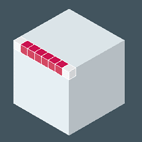
|
|
Next I needed to consider the faces of the cube, which are painted red on 1 side only. Each face is a square made up of (N - 2) x (N - 2) cubes. Since there are 6 faces, the total number of cubes painted on one side only is 6 x (N - 2)2.
|
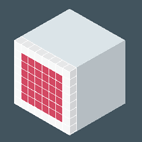
|
|
Finally, inside the large cube, there is a smaller cube, an N-2-Cube, made up of all white cubes. This requires (N - 2)3 small white cubes.
|
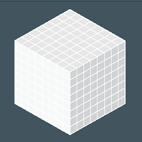
|
|
I put my results into a table to make it easier to calculate. By setting N = 4, I can find the results for a 4-Cube, to solve Problem 1.
| Name of Cube |
Total Number of Cubes Needed |
|
| Number of Cubes Painted with: |
| 3 red sides |
2 red sides |
1 red side |
all white sides |
| N-Cube |
N3 |
8 |
12 x (N - 2) |
6 x (N - 2)2 |
(N - 2)3 |
| 4-Cube |
64 |
8 |
24 = (12 x 2) |
24 = (6 x 4) |
8 = 23 |
I always like to check my work. One way to do this is to add up all four kinds of cubes and check that they equal the total.
For the 4 cube I get
64 = 8 + 24 + 24 + 8 = 64v
For the N-cube I get
N3 = 8 + 12(N - 2) + 6(N - 2)2 + (N - 2)3
When I expand the right hand side, I get
8 + 12N – 24 + 6N2 – 24N + 24 + N3– 6N2 + 12N – 8
Then collecting like terms I get
[8 - 24 + 24 – 8] + [12N – 24N + 12N] + [6N2 – 6N2 ] + N3 = N3v
So N3 = N3 and my formulas check!
|

